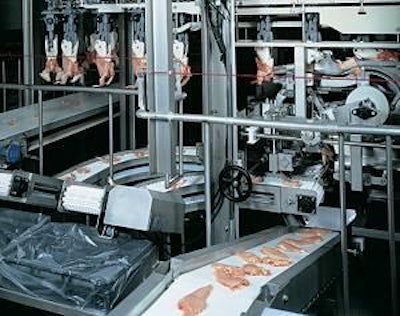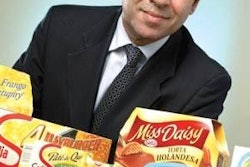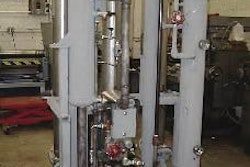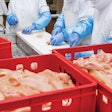
The 2010 International Poultry Expo (IPE) was a welcome relief after the economic recession of 2008-09, which worked to curtail investment in the poultry processing sector. Processors in attendance at the show were able to focus again on keeping up with the demands of customers and the updates in technology required for them to compete.
Making a comeback, after overcoming such serious economic hurdles, shows what kind of people lead – and supply – our industry. Equipment companies are now faced with catching up after losing many of their people with technical and industry knowledge during the recession. They are working hard now to apply their people to just getting out new orders – so innovations were generally difficult to get done.
The IPE had innovations in processing on display everywhere, some in the form of modifications and others with equipment being used in different ways. It seems that no machine stayed the same, if we looked closely.
Improvements under the hood
This report covers what was different since last year, based on a quick whirlwind of discussions among a few suppliers. The focus is on the processing area, and the main point to remember is that nothing is as it appears in the equipment at the show, if we look deeper. The supplier group for the poultry processing industry constantly updates their knowledge, their devices, and gain insights on how to better apply what they sell. Don’t let our brief descriptions take the place of listening to your suppliers and pressing them to do more.
Beyond optimizing the yields and efficiencies of today’s products, some key areas that many were discussing included ways of upgrading the leg portion of the birds and methods of capturing and upgrading the value of by-products. The Meyn leg deboner was a key piece of equipment since last year, providing a practical and yield-effective way to debone the whole leg. The search for devices to upgrade by-products was a more difficult quest. Most supplier companies have not detected a strong focus from processors in this area in the recent past.
Need for real-time information
Likewise, there were many discussions about plant cost and margin comparisons and the need for good, real-time information.
The plants all have unique customer bases and needs, but generally they have lists of the differences in their systems and plants with better efficiency or yields. The reality of outdated systems, or mismatched processes for customer bases, means plant updating, and many have gone too long.
The difference in “average” and “best” among plants is hundreds of thousands of dollars per week in net margins. Savvy equipment suppliers focus on valid methods to determine paybacks for including their systems and try to attach sensors that give real-time information that shows these are real.
Cut-up, deboning and gizzard machines
Marel Stork did a good job of exposing the component-to-component integration of their different devices.
One obvious example was the workstation and handling between the automatic deboner and the Marel X-Ray technology setup. The Stork FHF deboner has had modifications on every module, and there are now plants running the updated ones at 70 birds per minute (BPM). The balanced flows and workstation with built-in reject conveyance, means the setup takes minimal space and is balanced to work together.
The Stork cutup line was also upgraded by retooling every unit for good cuts at higher line speeds. There are companies running these at 120 BPM. Every module has been optimized with feeding, cutting or structure changes to achieve this.
Close inspection of every machine in the booth revealed that all had multiple improvements for yield or speed, and/or had been integrated into the flow with planned workstations.
Several gizzard machine improvements were obvious, but one was particularly good. Panels covering the cutting mechanism slide open to expose safety bars over the cutters. This allows a technician to watch the cuts, and then stop the device and open the cover to perform precise adjustments. After adjustments, the panels slide back into place to prevent overspray from the process. The old way was to adjust, and close, and adjust, and close … time consuming, and certainly time consuming to do safely. This is a great idea.
Yield-effective leg deboning
Finally, a leg deboner which gets good yield, simple, and very close to the strict specifications for the Japaneese market. The Meyn leg deboner operates at a 70 per-minute-plus rate and is compact enough to take the space of a dual manual line.
Chilling with control
Morris exhibited the Jet Bird – referred to as the Jet Bird 3000, or Jet Bird with Advanced Flow Management. Whatever it is called, it is far better than any screw chilling flow we have ever seen. A video of one in operation at a plant shows the rolling action of the birds between the auger spaces. Each bird stays in suspension without clumping in front of the auger. The chilling efficiency is far better, meaning that chill times can be reduced, and/or birds can be colder in the process.
Morris also introduced Quick Chill 3000 Control updates and a Disinfectant Optimization System.
Control systems on all the Morris devices seem to be different every year as they make the software more user friendly, and technology for sensors and feedback becomes better. The automation included ways to continuously monitor disinfectant dosing, means of controlling temperatures, and internet/intranet alarms that are great examples of a group that seeks to keep important processes at peak efficiency.
Splitting gizzards, segmenting wings
Prime Equipment Group introduced a completely new turkey gizzard processing machine, which uses a high-pressure water jet to split turkey gizzards. This replaces the traditional, and costly to maintain, circular blades.
The company’s shoulder-and-neck skinner, from last year, can now be suspended and attached to cutup lines to address only birds headed to deboning. This exposure of the shoulders increases breast meat yields, because the shoulder cutters can see the exact place to position the knife at the shoulder cutters.
Prime’s upgraded Wing Segmenter has completely different product cavities and product guides to allow for better wing positioning prior to cutting. These changes deliver a more consistent end product with fewer miscuts.
Cutup and sizing systems
The Foodcraft-Star-Greenline group of suppliers joined forces to achieve a method to size and cutup big birds (over 8 pounds) after weighing them on-line.
Greenline started with the proven, and bulletproof, heavy-duty 348 overhead line, and used the normal 3-inch “dog-bone” part that holds the trolleys steady, but uses lengthened 5-inch side-plates to provide a seriously heavy-duty 8-inch-center overhead line. Foodcraft fitted the proven halvers and leg processors with gearing and feeds for the new centers.
Star developed a weigh-lock shackle that remains ridged in the cutup process, but which provides a couple of wheels that unlock the shackle for weighing when lifted for the weigh-deck. This combination allows the line to be hung with any size of birds, and then allows for weighing and removing the ones that do not fit the size range needed.
Packaging breakthroughs
This area constantly changes, but this year there are a couple of breakthroughs in practical compostable products to fit the need for environmentally friendly product packaging. Compostable packaging is a serious need, and both Pactiv (to replace parts packages) and Interstate Container (to replace difficult to compost, wax impregnated boxes) showed some new and practical technologies for these.
Pactiv introduced a new poultry tray that is made from compostable materials. This can take the place of Styrofoam materials in retail as higher demands for environmentally friendly materials become specified.
Interstate Container Cambridge introduced a compostable poultry box to replace waxed boxes. This provides a practical, and cost effective, way for plants to meet environmental goals and customer requirements for sustainability.
Cryovac answered the consumer’s question, “How do I open this thing?” with the first easy-to-open vacuum bag. The demonstration took one second, so this is certainly something consumers will welcome. Suitably named the “Grip & Tear,” consumers just pull apart the two holes in the end to split the film, neat and easy.
Heat and Control. Hot wings, chicken salad, roast chicken….any item which needs a sealed and even co2 purged pack needs a high speed and dependable tray sealer. The need for serious-duty machines was addressed by the Ishida QX-1100 Tray Sealer. Speeds up to 200 trays per minute and a twin-lane configuration option make this tray sealer state of the art.
Busy in the processing sector
It has been more difficult to get information and graphics from suppliers for this article this year. This is great news, because the reason in every case is that suppliers are busy with customers asking them for order-related information.
My sincerest wish in presenting this brief listing is to provide a few ideas of value to your company, and to your personal career. I am quite sure that some valuable find was left out from some very important suppliers, for which I apologize. We do encourage the personal relationships with the fine suppliers to this industry for whom I have the deepest respect.

.jpg?auto=format%2Ccompress&fit=crop&h=167&q=70&w=250)













